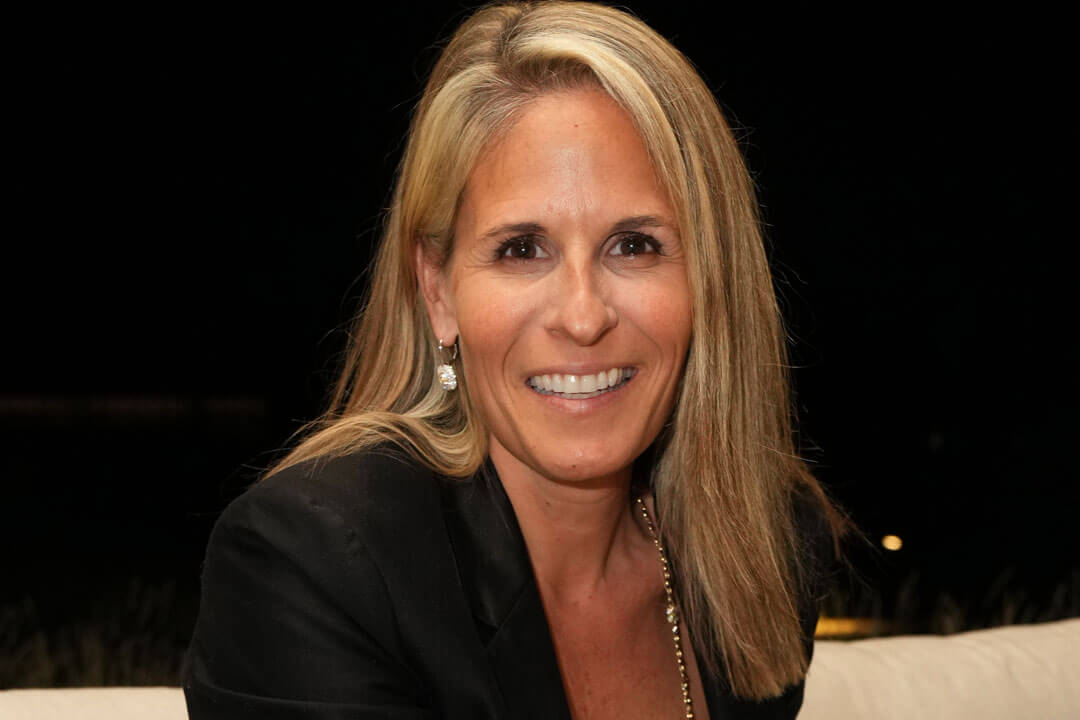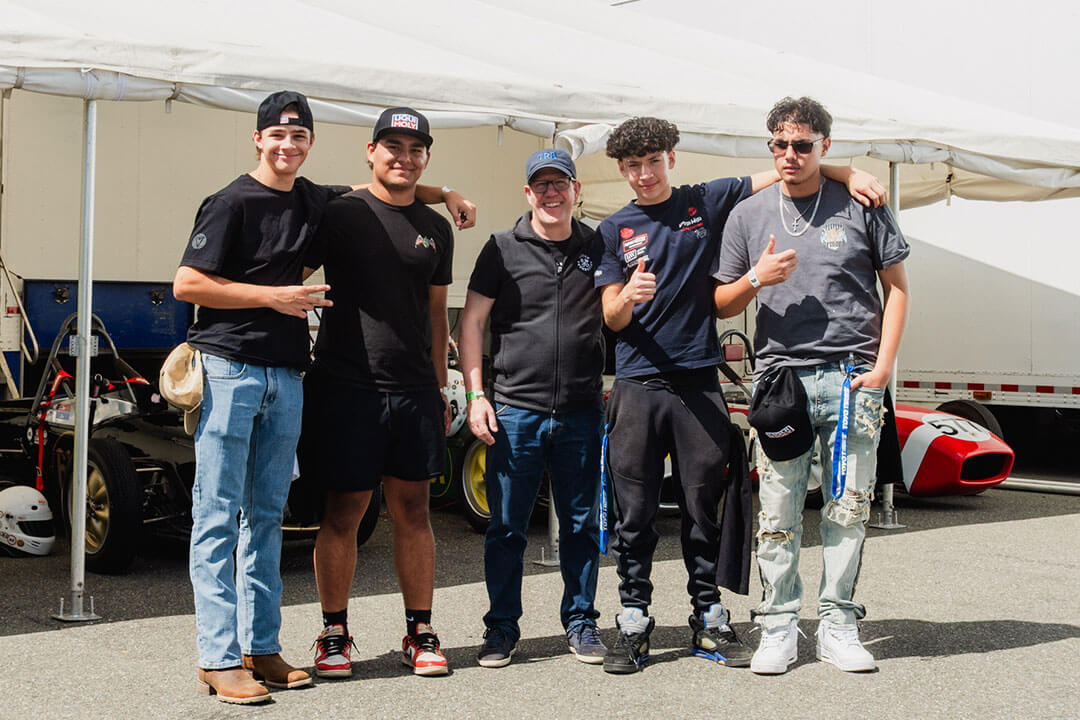The Rookie Record
In 2011, Harvey Siegel and his Team Siegel did something rare, they set a world land speed record on the Bonneville salt flats on their first attempt. The car Harvey and his son Luke drove to the record was a 1999 Mazda Miata MX5 prepared by Ryan Pilla, “The Car Doctor”, especially for the attempt. Team Siegel worked tirelessly for a year to develop a car capable of breaking the GT class record.
Harvey has donated the 2160 Miata (as in “Going to 160 mph”) to Piston. The car will be featured at MiataCon at Lime Rock Park and auctioned on Bring-a-Trailer. 100% of the sale will go to the Piston scholarship program. This is the story of Team Siegel’s rookie record.

By Raffi Minasian
October 5, 2023
[addthis tool=”addthis_inline_share_toolbox_a1tk”]
This article was originally published on Sports Car Digest and is re-published here with the permission of the author.
The holy grail of land speed records resides in the vast solitude of a formerly thriving prehistoric lake. 14,000 years ago, this epic lake flooded out, evacuating the equivalent of Lake Michigan into Idaho’s Red Rock Pass. This devastating flood would last for over a year, continuously moving trillions of gallons of water with speed and intensity beyond anything we can comprehend today, reshaping much of the state of Utah. The devastation eventually subsided, yielding miles of vivid white salt-encrusted landscape known today as the Bonneville Salt Flats.
Long before mankind dreamed of speeding across land, this very same place teemed with life; a fluid world of its own, now enchanting mankind to challenge the fluid dynamics of air, in their quest for more speed. Today the searing heat and desolate landscape reveals an almost lunar quality of unfathomable scale. But as much as the landscape itself draws one to the majesty of nature, it is the remarkable call of competition, challenge, and innovation that every year draws legions of dedicated motorsports enthusiasts to exceed the coveted land speed records for their class.
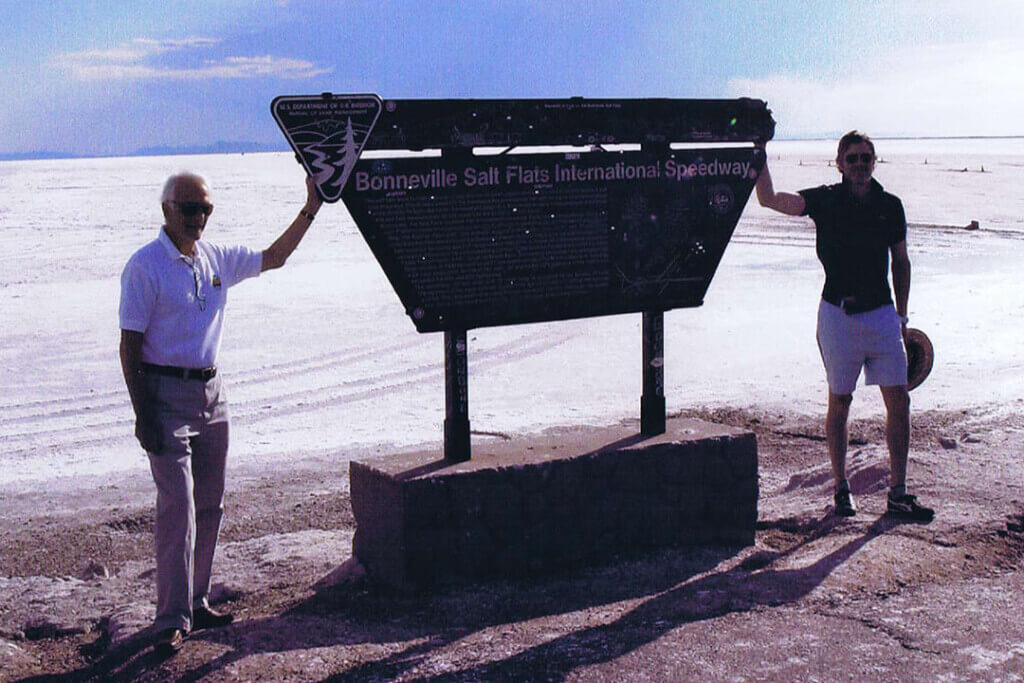
Bonneville is a hypnotic place. For anyone who has ever witnessed the terrain, it is shockingly hot, viscously bright, and yet strangely alluring. Without proper protection and precautions, human life in such extreme conditions would struggle to survive. It is all the more fitting that anyone coming to Bonneville to set a record, has to be prepared. Not just to go fast, but to do so with absolute certainty, consummate planning, and intense focus. You have to be ready to meet the desolate landscape with imagination and fortitude. Arrive unprepared and Bonneville will frustrate and overwhelm you.
Harvey Siegel is no stranger to challenge. A genuine entrepreneur with lifelong professional interests in a wide range of businesses, a stint in the Army, and a college degree in business, Harvey was eager to start his career in the mid 1960s. In the 1970s and Sos, he found growing opportunities with his family business in real estate development. Although the majority of his ventures were focused on building retail shopping centers, Harvey pivoted to a new challenge in 1998 when he took on the restoration of The Virginia International Raceway. VIR had sat dormant for more than 25 years. Like the vast Salt Flats of Utah, VIR had also once teemed with the infectious energy of racers, engineers, supporting a thriving motorsports community. But the changing economy and a national gas crisis had starved VIR out, leaving it a vast landscape of forgotten motorsports dreams. Harvey, having been a gear head all his life, taking mechanical devices apart, and marveling at the leftover pieces after putting them back together, felt compelled to bring VIR back to life. After careful consideration, he assembled his team and prepared for the construction and restoration. Although the project began with planning, focus, and determination, there were challenges at every step of the process, learning that anything complex takes hours of focus, deep collaboration, and most importantly finding and motivating the right team. Fourteen II?-onths later in March 2000, VIR opened to its first year of complete operation. VIR has smce gone on to become one of the most revered motorsport facilities in North America, followed by a second racing facility, New Jersey Motorsport Park, which opened in 2008. Having met these challenges and lived so closely to the energy and dedication of motorsports enthusiasts, Harvey heard the words of the great motors ports announcer, journalist, and NASCAR Hall of Farner, Chris Economaki when asked what his favorite motorsports event was “Bonneville is the most captivating and exhilarating motorsports event I’ve ever attended”. Harvey set his sights on the desolate Bonneville landscape with one goal in mind; he and his son Luke would assemble the best team, rigorously prepare, and with just one rookie attempt, set a new Bonneville land speed class record.
“Bonneville Speed Week” is the culmination of planning, testing, and more often than not, years of intense study, prototyping, and reengineering your ride, all for one goal; to go faster than anyone ever has in their chosen class. A living event with continuous participation dating back to the 1930s, the unusual combination of mechanical intensity coupled to the unforgiving climate of Bonneville would ultimately nurture the very foundation of the American Hot Rod movement, innovating our Car Culture in ways that still reverberate today. Indeed, nearly all hot rods owe their origin, stance, engine configuration, tire specifications, and custom body work to the themes first established by young motorsports innovators challenging the salt. The history of Bonneville includes thousands of highly capable and brave “gearheads” many with victories, some with tragic deaths. And while each of these participants are all dedicated enthusiasts investing thousands of dollars and often years of preparation, many arrive at Bonneville, only to be sidelined by a host of roadblocks including the rigors of intense technical inspection and safety review, mechanical failure, rule book misinterpretations, or something as simple as rain. Each of these ongoing obstacles offer no sympathy for the intrepid, leaving them no choice but to return the following year.
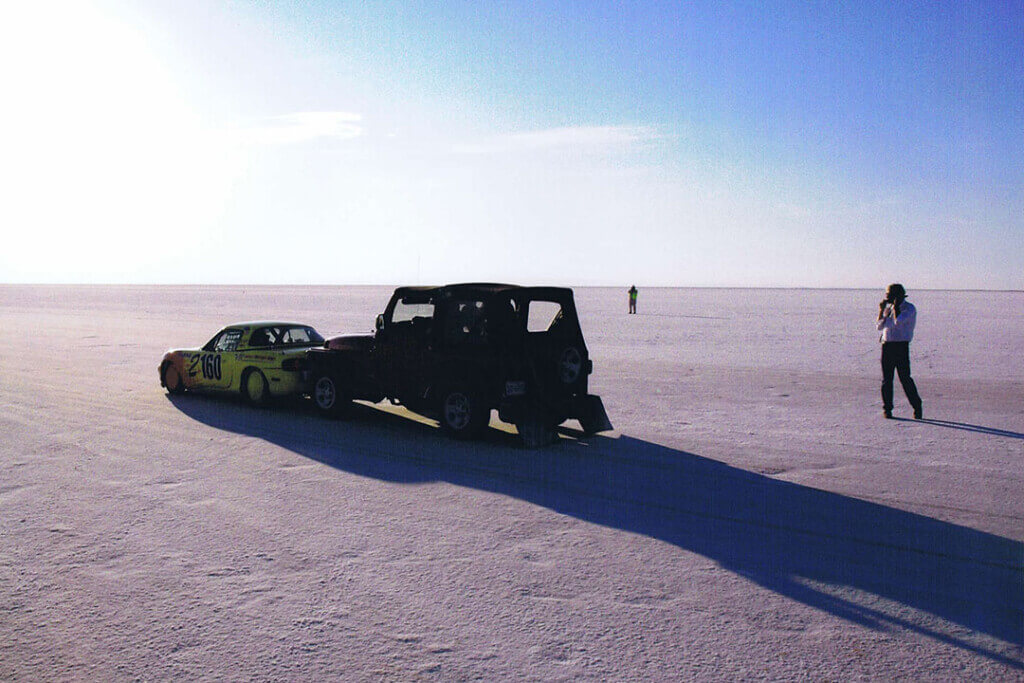
With the rigors of Bonneville clear and the realization that far more contenders go home defeated than logged in the record books, Harvey knew that preparation at every level would be key. The more he studied past successes and failures, the more he realized his competition would not only consist of equally dedicated professionals making their second or third attempts, they too would be featuring the very best in engineering and preparation in each of their cars. To truly understand the scope and challenge ahead of them Harvey hunkered down just as he had with so many other projects; engaging thoughtful and dedicated research. By scouring previous records and studying which ones might be vulnerable, a potential opening emerged. The 2 liter GT Production Class showed itself to be the perfect candidate for a carefully orchestrated team approach to beat the existing record, 158.5 mph. As the class and potential car became clear, Harvey began researching the right mix to form a team of experts, not just for their skills or previous successes, but a team that could bond together, stay focused on the collective goals, and maintain a positive perspective on the project. The goals now becoming more defined and key elements falling into place, Harvey and Luke set their sights on 160mph, hence the name “Going 2160” (Going To-160), which would eventually be emblazoned on the doors of their record-breaking car.
Who You Pick Is As Important As What You Run
The Mazda Miata is perhaps one of the most important cars of the 20th century. Celebrating their 100th anniversary in 2020, Mazda was something of an oddity in the 1970s when Japanese cars were emerging in North American markets. Their curious rotary engine in the ill-fated RX-2 left a bad taste for many customers, but engineering persistence delivering the much-improved RX-7 as a worthy sports car. The RX-7 not only built a new reputation for Mazda, it established them as a company with growing Motorsports interests. But as successful as the RX-7 was, no one could imagine the success of the diminutive Miata when it debuted in 1989. The appeal was immediate, with attention from a wide range of buyers who craved convertible twin-cam excitement and sports car handling with reliable mechanicals. Sales were unprecedented. Additionally, hundreds of aftermarket components supported the Miata clubs and enthusiasts from all over the world. Not only was it a great production car, it had the bones for much more performance. The very same ideals that created this remarkable car echoed as the perfect platform for the 2160 assault. But the challenge remained; how could a 115hp car with a top speed of 126mph achieve 160mph, and who were the experts that could make such magic happen?
With the right car chosen, the next step was to assemble a team of experts and begin the transformation from ground-breaking sports car to record breaking salt flats car. The Miata already had a lot going for it to make the record run. The factory aerodynamics were impressive for a car of this size, the engine design was flexible enough to allow for much higher states of tune, and the unibody structure was ideal for modifying an already durable platform into a robust and safe Bonneville racer. A low mile, pristine condition, California car was located and purchased in part because a solid original car would need no metal work and any safety modifications could be done to a factory tooled and assembled car, benefiting from millions of dollars of precision Mazda engineering and body integrity, vital elements for attempting high speed runs.
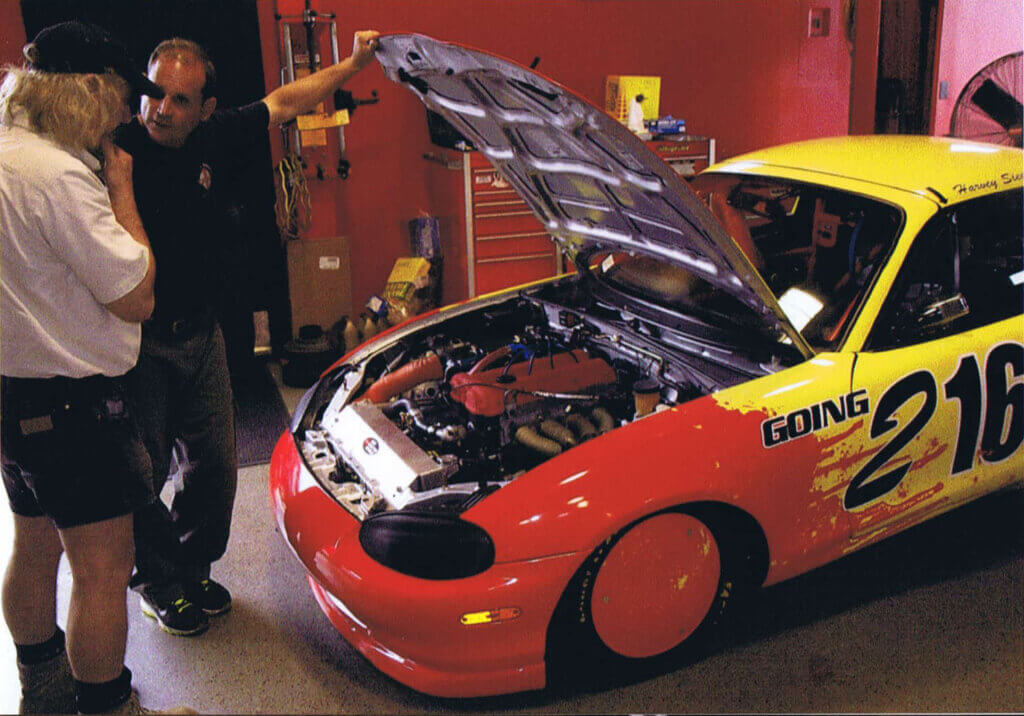
There are a lot of people who can build an engine. Many more still who can build a chassis or engineer just the right balance of performance and durability needed in a racecar. But finding someone who can do all those things in a short time, and with the dedication and fortitude to meet the rigors of Bonneville, creates a very short list. Enter Ryan Pilla, “The Car Doctor”. Ryan grew up with gasoline in his veins. If it had wheels, Ryan was immediately figuring out how to make it go faster. Not just more speed, but faster than anyone else. Ryan’s list of expert skills included building, engineering, designing, and racing all sorts of specially constructed performance cars. But his specialty had been pioneering methods to achieve more out of a stock Miata. Studying the 1.8 Liter stock engine, Ryan began working on plans to machine and refine an engine within one hundredths of the 2 Liter capacity in order to pass the qualifications for the GT class. The engine would not only have to put out something in the range of 250 hp (more than double the stock output) in order to achieve the record, the entire drivetrain, chassis, and suspension would have to be modified to create a total package capable of managing all that power and effectively delivering it to the rear wheels. In order to do that, the Mia ta would consume all of the stock horsepower to get to 125mph and an additional 14bhp to get to 160mph.
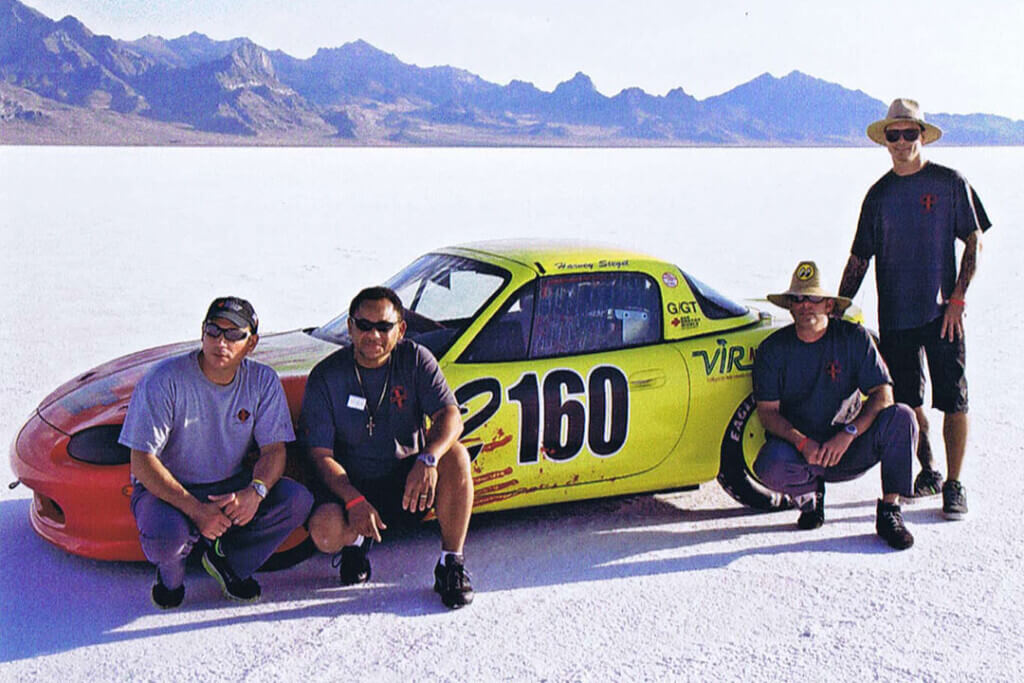
Adding to the engineering and build team, Car Doctor team member Ron Davidson would be key to fabricating much of the safety systems, roll cage, safety harness, and driver controls needed to make the record run. Other team members included Charlie Exton, the glue of the team, keeping everything together under pressure, managing transport and prepping for Bonneville set up, Andy Lure managing logistics while being the go-to all-around handyman, and Luke Seigel, driver and co-visionary for the record run. With the team now in place and many more members already contributing to the preparation, it was time to focus on one of the most critical members of the team; the car. The entire stock Miata was completely disassembled, leaving only mission critical elements needed for the record run. The unibody was checked for any flaws and all components x-ray tested to be sure no components would fail during the attempt. Having lightened the Miata and reconfigured the suspension, the engine was sent to Peter Marcovicci who worked closely with Ryan to determine the very best ways to increase horsepower without compromising the durability needed to maintain the multiple qualification passes required to beat the record. The final engine build tested at 290+ hp running an astonishing 14.5:1 compression on approved pump race-fuel. Although an engine like this was clearly built for record runs, it was right on the edge of performance capacity – a delicate balance of machine capacity and driver grit. A combination that would ultimately define the record run just a few months away as the team began to assemble for their assault on Bonneville.
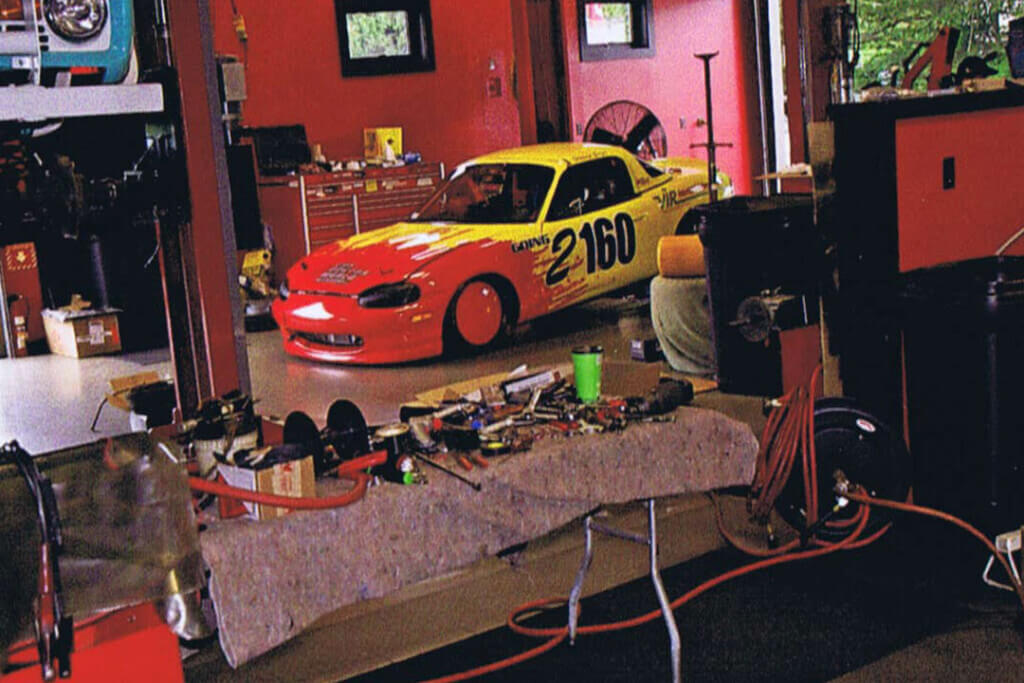
“If everything seems under control, you’re not going fast enough” – Mario Andretti
Going to Bonneville without a practice run meant only one thing; the team had to prepare like astronauts going to the moon for the first time. Anyone with space travel experience will tell you the key is to prepare for all possibilities and as many of the improbably impossibilities you might encounter. With a 9,000 rpm engine detonating more or less like a hand grenade, temperature, humidity, atmospheric pressure, all contribute to managing the engine performance. Sitting at full throttle in a Long Island dyno station might tell you the engine output, but it’s a far cry from the realities on the salt and a 5,000 ft elevation above sea level. With no real way to test the car on the streets of New York, all preparation and dedication was focused on getting the car to peak performance levels but also allowing for flexibility and ease of adjustments once the team was on the salt. Ultimately for the rookie team, Bonneville would be the ultimate arbiter of their preparation.
Arriving at Bonneville for the first time, one is immediately overwhelmed by the sheer scale of it. The white landscape pours out in front of you in all directions, flanked by legions of distant silhouetted mountains. There are no markers, no building, no reference points for scale or speed. You simply drive forward into distant coordinates with the faith that you will arrive where others await you. Soon, rippled visions of color and shape appear in the distance, where hundreds of dedicated enthusiasts have gathered with one collective goal; to go faster than anyone has before. But as much as competition is a key element of Bonneville, the community is helpful, supportive, and eager to share their experiences. Everyone wants to achieve their goals, but they do so with fairness, respect, and camaraderie. Everyone wants to go home with a record, but more importantly, everyone wants to go home safely and without injury.
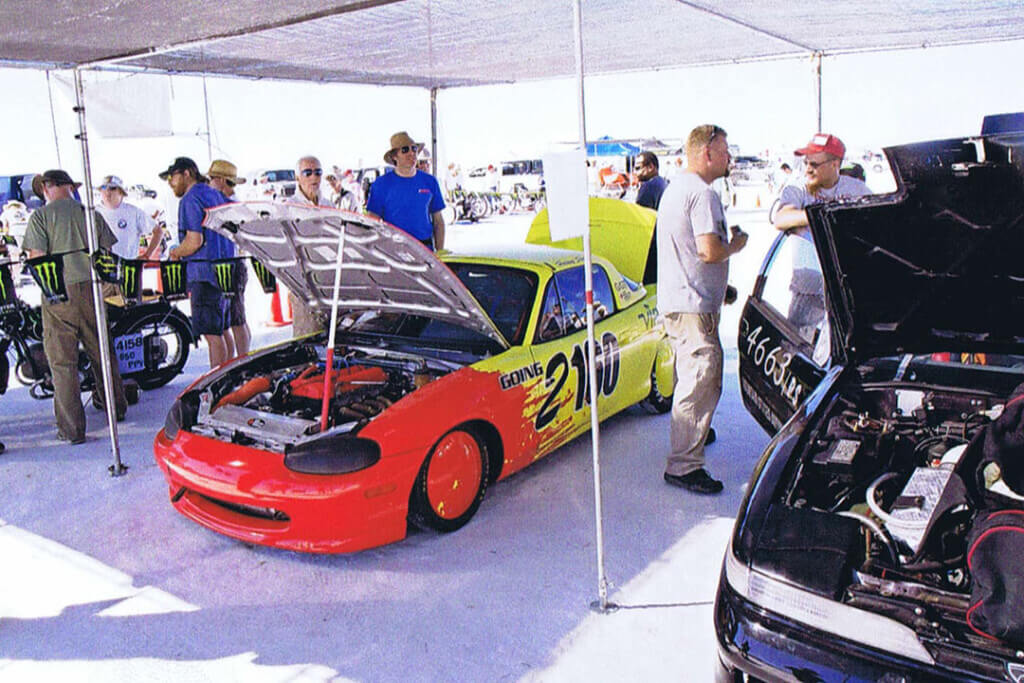
Technical inspections, stringent safety reviews, and every aspect of scrutineering you could possibly imagine are demanded by teams of dedicated experts studying every aspect of your car, your drivers, and your capacity to perform at peak levels. The day began with the Miata submitting to full inspections, beginning with the engine, which was measured and reviewed in detail to be sure everything had been properly prepared according to the rule books. Being rookies to Bonneville, the team was subjected to even higher levels of review. Fittings, hardware, components, were all critically studied, and in each case, Ryan and the team quickly responded questions, clearing up any concerns, while quickly innovating solutions. One of the few moments that caused concern was cleverly solved through the use of clear packing tape to act as a structural sheath when taped over rear glass that was not tempered and laminated, necessary because of the need to contain glass shards in the event of breakage. Further scrutineering including the challenge of both father and son being able to exit the car in under 30 seconds, a move that seems simple on the surface, until considering the stiff HANS device, protective roll cage, removable steering wheel, and a window net door opening. The level of contortions and agility required made it a challenging feat for both father and son. With the car having passed inspections, the emergency escape contortions confirmed, and the challenging terrain clear of poor weather, all that remained was to study the ambient temperatures, wind conditions, and study the salt conditions. It was time for the first run.
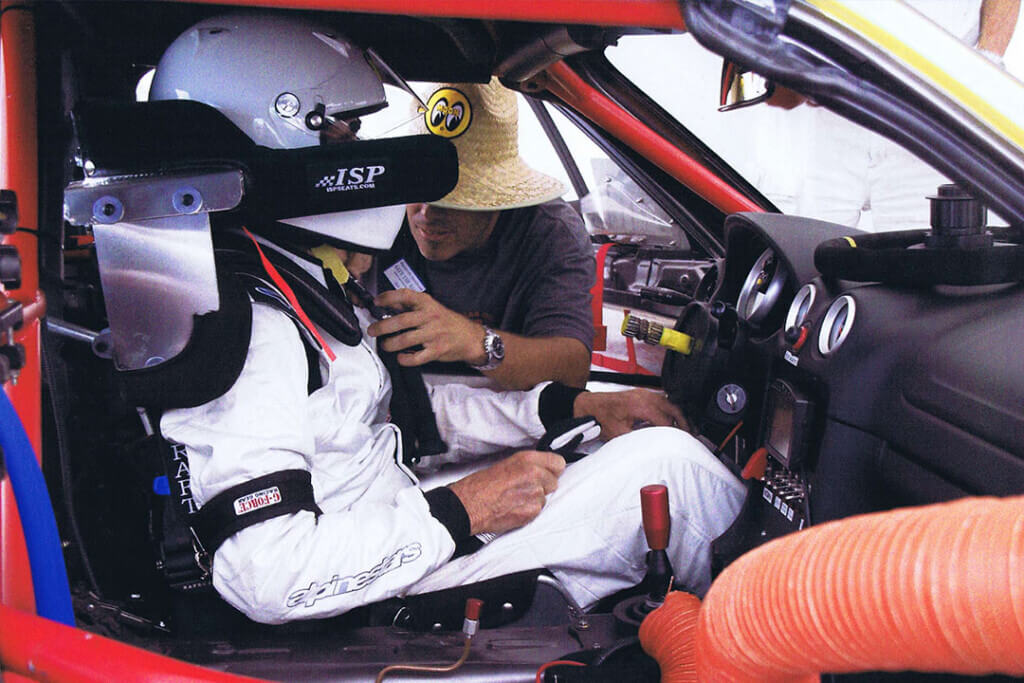
Harvey prepared for the first run, designated by officials to hit 125mph. It sounds simple. Get in, hold on, and press the gas pedal. But it’s quite a bit different with a specialized car built to run a speed record. Shift points, revs, keeping the car stable, and holding it straight and smooth through the mile markers are all components that compound into an intense level of detail requiring clarity and composure. At the speeds you are traveling, things seem slow outside, until you start threading the black pole markers which gradually start flying past you at increasing intervals. With all the preparation and dedication behind them, Harvey stepped into the land speed record Miata; a car that had only been driven at 40 mph. In his first chance to drive it, Harvey had to control a 9,000 rpm engine with just the right revs to achieve 125mph, right in the sweet spot, threading the markers, gradually moving up to speed, and then smoothly shutting it down to return to the next run. Behind the wheel accelerating through the course, Harvey recalls “At a certain speed, you have no friends. It’s just you and the car, working together, paying attention, doing things slow and measured, covering that giant white expanse. It’s a very surreal experience. A spacey kind of feeling out there on your own.” Pushing through the markers, Harvey completed the run well ahead of his speed marker, emerging with confidence knowing that the car had plenty more speed and power to give. It was time for Luke to prepare for his rookie run, but this one was going to have to be 2-160.
“Today’s amateurs are tomorrow’s champions.”
Luke Siegel is no stranger to competitive sports. A premier high school wrestler, All State Defensive Tackle, and All State Conference Running Back, he ranked #2 in Delaware State as a competitive high school wrestler. Not content to rest on his sporting achievements, and frustrated with the structure of typical schooling, Luke ventured on his own, blending his father’s entrepreneurial drive with his mother’s designer eye, eventually launching his own company, Raydoor, founded on his passion for furniture design. Captivated by cars, including ownership of a Boss 302, Dodge Challenger, and having participated in more than a few racing schools, Luke cultivated a good grasp of what it takes to drive competitively. When it was time to take the wheel, ultimately it would be his conviction to hold course and stay totally focused on one goal, a challenge that even Luke admits was not always his best trait. “Breaking the land speed record was really my father’s crazy idea. But it became more real with each day. He’s like that, methodical and measured, day by day, breaking it down and then building it up. We’re very different in that way, I dive in the lake while Dad’s on the dock taking the water temperature. But like so many partnerships, both our personalities were needed in this project. I think he knew that when it came time to run the second pass and he graciously handed it to me. It was my fearlessness and reactive instinct coupled with his measured plans that made just the right combination at the right time. Dad knew the planning was done and we both knew what had to happen next. When I look back on it, what Dad and Ryan did to get us on the salt was nothing short of monumental. When it was my tum to take the wheel, all I could think of was – just don’t Fit up.”
With the previous day behind the team and a solid first run banked and recorded, it was time for Luke to make the second pass. Record runs are entered on a calculation of the combined average from both runs. In order to achieve an official record, Luke’s run had to be flawless and faster. A lot faster. Fortunate to obtain an early slot in the next day run, the team saddled up for a 3rd position just after sunrise. Dawn rising on the salt is unlike any other experience on the planet. The air is still, the salt is crisp from the night air as it slowly warms under the rising heat. The silence is broken only by nervous whispers and the crunching of salt beneath your feet. As the sun moves across the vast white flatlands, an orange cast blankets everything, even the most stoic pause to take it in. Moments later, the engines erupt, breaking the stillness, and it’s back to business as the teams line up for their next pass. The months of planning, measuring, calculating, revisiting redundancies, and implementing safety measures, all come down to a matter of moments heading into the starting position.
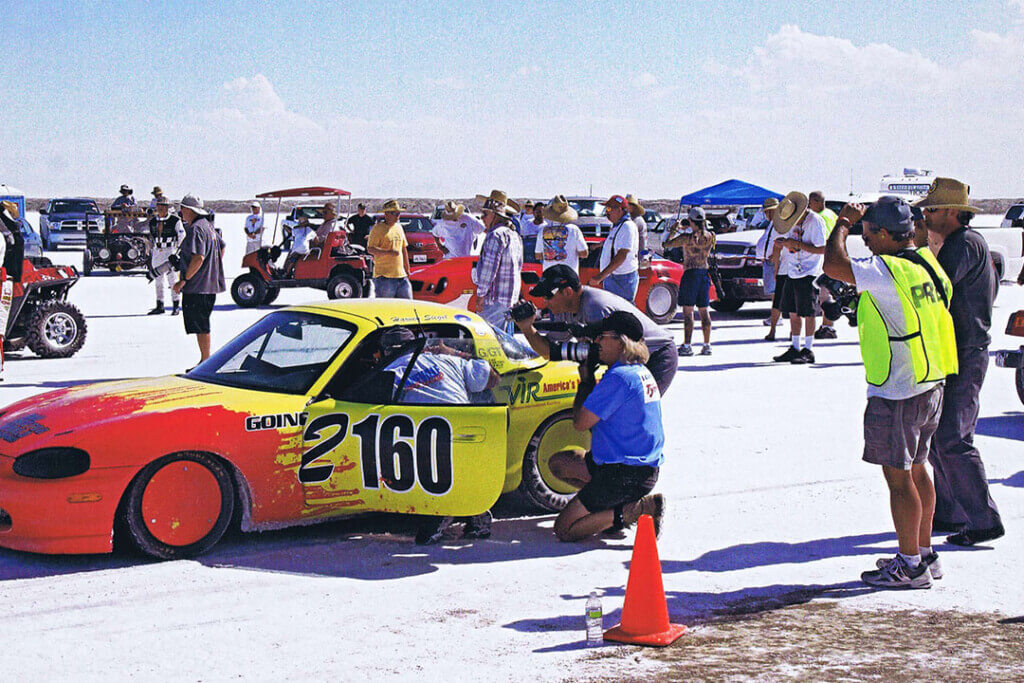
Luke, now belted inside the car, takes last minute instructions from Ryan advising him to watch for slipping and to let the car run to its full potential. “When you hit third gear, you’re going to roll into it and never look back. All the way. Full throttle.” Ryan’s words rang in Luke’s ears as he lined up ready to do what the team had so thoughtfully planned and strategized over for so many months. As the car disappears into the rippling white heat waves, Luke gains speed, shifting at key points, but quickly realizing the engine temperature is rising. Not just a little bit…it’s way past normal. Luke knows the temperature needle needs to stay straight up the middle, but there’s no turning back. No amount of planning, calculating, or measuring is going to change the outcome. It was exactly down to the reason Luke was behind the wheel; go with your gut and trust the machinery – it’s time to dive into the lake. Luke held fast, taking fifth gear, keeping his foot in it, pushing the very limits of the engine as it howled approaching the edge of the power curve, burning way beyond safe temperatures. “If she blows, she blows.” Luke thought, ”I’m not lifting.”
Then, like so many things at Bonneville, time stood still, the tires hovered over the salted plumes, the air gave way, and the Miata split the last marker at full speed. Luke backed off the throttle, settled into the slowdown mile, finally coming to a halt. And just like that, it was done.
The team waited as the officials confirmed their calculations, while the car returned to impound for technical inspection. With the two passes now done, tech inspection complete, and the team eagerly waiting, the final announcement was made. Team Siegel had set a new Bonneville Land Speed G/GT Record of 165.296 miles per hour. Luke’s pass had proven to be more than 173 miles an hour, itself a mind-boggling number for a four-cylinder production car assembled and campaigned by a rookie land-speed team.
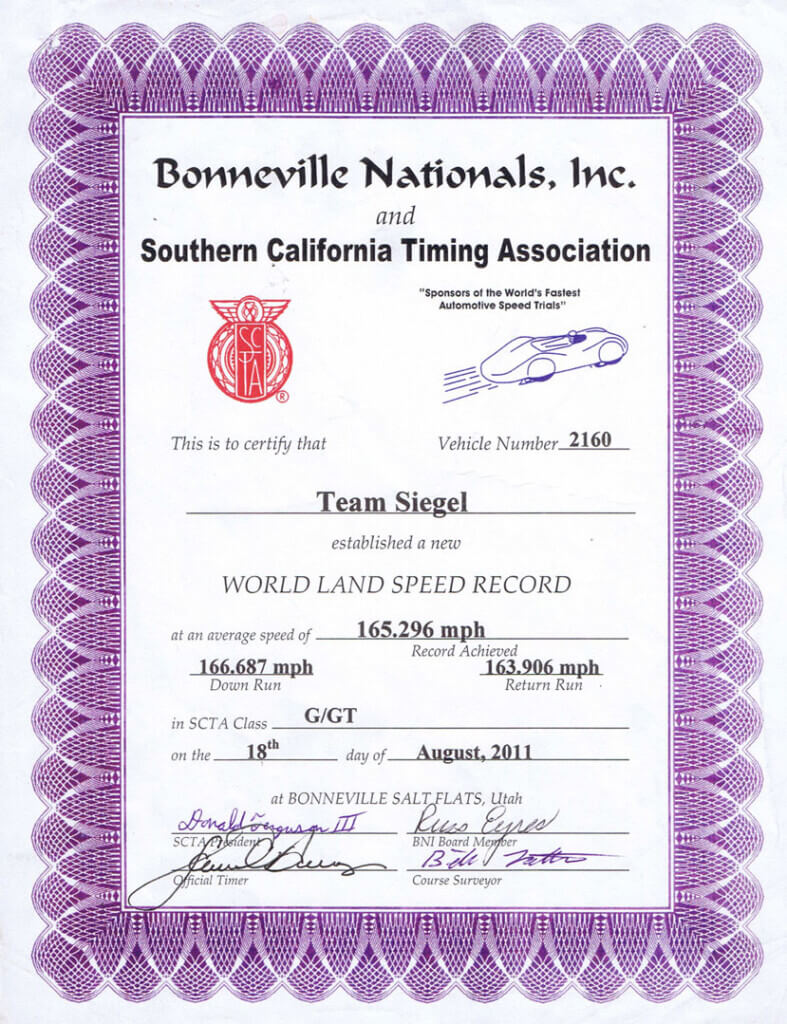
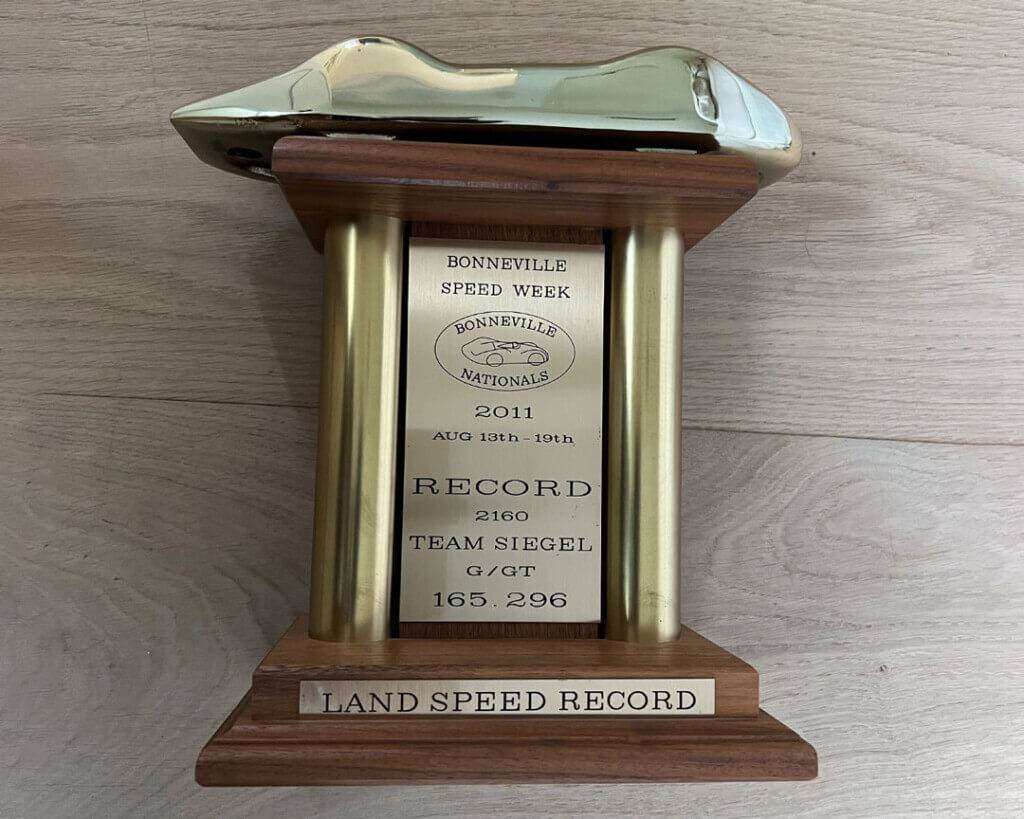
It’s been almost a decade since the record was set in 2011. The record stands today, unbroken. But it’s not a record that Harvey hopes will stand for long. The captivating and amazing collection of people and machinery that drove Harvey to do what seemed impossible is the same drive he hopes to use as encouragement for other dreamers. Acknowledging the personal, professional, and financial resources it takes to achieve such a goal, Harvey maintains that it was more than a dream, it was the determination and momentum, the partners, the planning, and the will of the team that made it happen. Something he devotes much of his energy to as a mentor in programs that encourage young people to be the dreamers of tomorrow. “To engage your energy, efforts, and intellect to do something you really believe in, and achieve your dream, it’s a very noble, exciting and satisfying endeavor. I’m always willing to help those who have a dream. I never say it can’t be done. Without dreams, half the things on this planet would have never been done – and if you’re going to dream, why not dream big and shoot for the moon.”
The Rookie Record Documentary
Epilogue
Nearly a decade after the record was set, Harvey Siegel continues to dedicate his time helping young people achieve their dreams and goals through ongoing mentorships. He is currently working on an innovative airborne craft that he promises will be a game changer in the aviation world. Luke continues to lead the team at Raydoor, growing and expanding their product lines recycling and repurposing unused materials into innovative products. Ryan and his team of motorsports experts continue to race, build, and set records both personally and with their clients. Bonneville Speed Week is still held annually on the vast Utah salt, waiting each day, at the crack of dawn, always ready for the next team of intrepid dreamers.
Donate
Today
Support skilled trade education for future auto restoration technicians.
Campaigns
Give to What You Love
Make a gift that helps the next generation access the education and training they need to begin a career as a classic car technician. Gifts of any size are appreciated and will be used to fund our scholarship and apprenticeship programs.
Sponsor a Piston Scholar
Piston Foundation scholarships are awarded to aspiring technicians to help them begin an auto restoration career. Give to the car culture you love. 100% goes to fund scholarships.
Cars for Piston Scholars
Turn your collector car into education and hands-on training for aspiring collector car technicians. Your car can change lives. 100% goes to fund scholarships.
Give to What You Love
Make a gift that helps the next generation access the education and training they need to begin a career as a classic car technician. Gifts of any size are appreciated and will be used to fund our scholarship and apprenticeship programs.
Sponsor a Piston Scholar
Piston Foundation scholarships are awarded to aspiring technicians to help them begin an auto restoration career. Give to the car culture you love. 100% goes to fund scholarships.
Cars for Piston Scholars
Turn your collector car into education and hands-on training for aspiring collector car technicians. Your car can change lives. 100% goes to fund scholarships.
Subscribe
Sign up for our monthly email with stories, updates, and volunteer opportunities.

